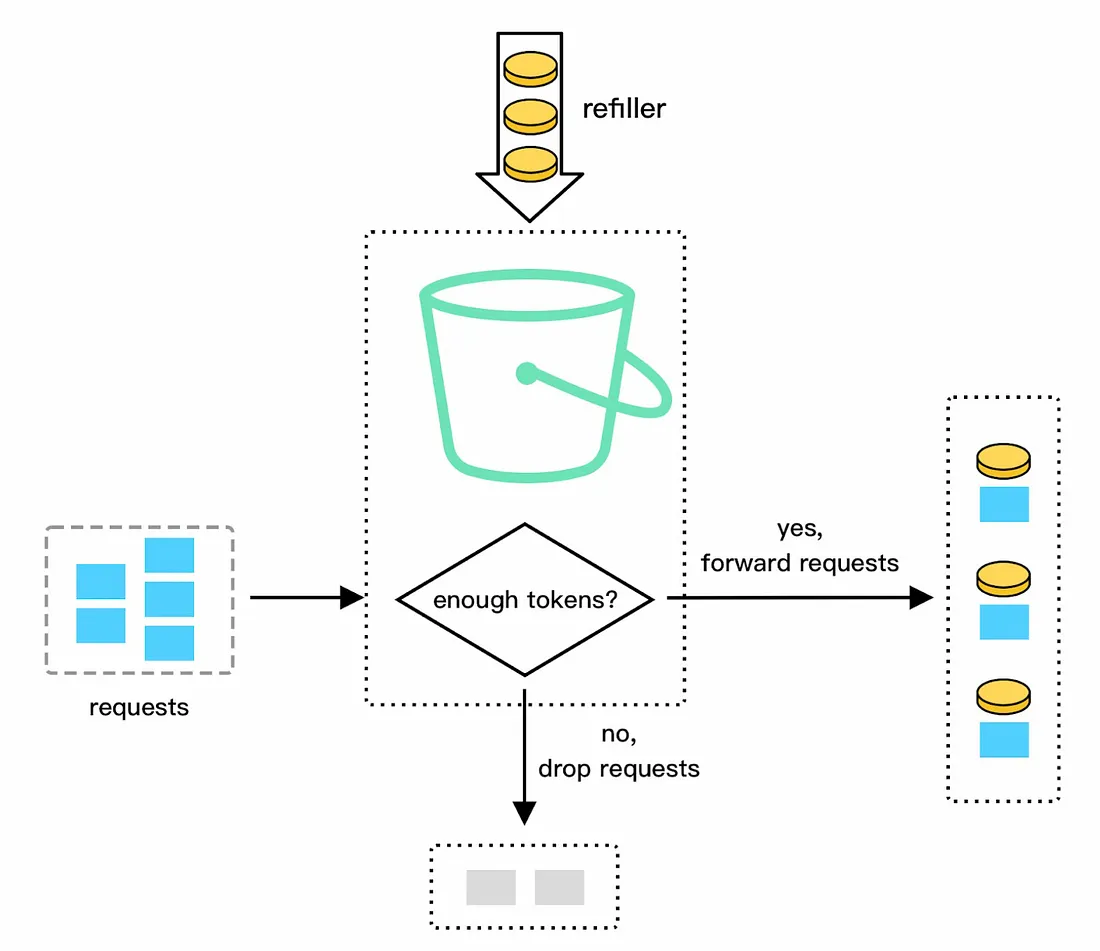Token Bucket算法
对于一个Web API,限流(throttling)是一个很重要的组件,主要有两个作用:
- 限制总体流量,从而保护Web API本身以及底层的组件。
- 限制每个用户的流量,从而避免一个用户的大量访问影响到其他用户,保证公平性。
Token Bucket算法是一个非常经典的限流算法。
Token Bucket算法介绍
如图所示,Token Bucket算法会维护一个装有tokens的桶,桶的容量是有限的,并且每隔一段时间会补充tokens。
当一个请求到达时,首先尝试从桶里获取一个或多个tokens,如果成功,就继续执行,否则就拒绝掉这个请求。通过这种方式,就可以限制请求的数量。

Token Bucket算法有两个重要的参数:
- Capacity:桶的容量,即tokens的最大数量
- Refill Rate:补充tokens的速度
在实际使用时,Refill Rate对应于请求的平均数量,而Capacity对应于瞬时可以处理的最大请求量。Capacity通常比Refill Rate大一些。
另外,在实际使用时,可以为不同的场景设置不同的Token Bucket,从而满足不同场景的限流需求。
Token Bucket算法实现
Token Bucket算法的C#代码实现如下。
TokenBucketOptions类
首先,定义一个TokenBucketOptions类,负责定义算法的关键参数,即Capacity和Refill Rate。
public class TokenBucketOptions
{
public int Capacity { get; }
public int RefillRatePerInterval { get; }
public TimeSpan RefillInterval { get; }
public TokenBucketOptions(int capacity, int refillRatePerInterval, TimeSpan refillInterval)
{
ArgumentOutOfRangeException.ThrowIfNegativeOrZero(capacity);
ArgumentOutOfRangeException.ThrowIfNegativeOrZero(refillRatePerInterval);
if (refillInterval == TimeSpan.Zero)
{
throw new ArgumentException("Invalid refill interval!", nameof(refillInterval));
}
this.Capacity = capacity;
this.RefillRatePerInterval = refillRatePerInterval;
this.RefillInterval = refillInterval;
}
public double RefillRatePerMs
{
get
{
return this.RefillRatePerInterval / this.RefillInterval.TotalMilliseconds;
}
}
}
TokenBucket类
然后,定义ITokenBucket接口和TokenBucket类,负责实现算法。
public interface ITokenBucket
{
bool TryConsume(int requestedTokens);
}
public class TokenBucket : ITokenBucket, IDisposable
{
private readonly int capacity;
private readonly int refillRatePerInterval;
private readonly TimeSpan refillInterval;
private readonly Timer refiller;
private readonly object lockObj = new object();
private int tokens;
private DateTime whenLastRefilled;
public TokenBucket(TokenBucketOptions options)
{
ArgumentNullException.ThrowIfNull(nameof(options));
this.capacity = options.Capacity;
this.refillRatePerInterval = options.RefillRatePerInterval;
this.refillInterval = options.RefillInterval;
this.tokens = this.capacity;
this.whenLastRefilled = DateTime.UtcNow;
this.refiller = new Timer(_ => this.Refill(), null, dueTime: this.refillInterval, period: this.refillInterval);
}
public bool TryConsume(int requestedTokens)
{
lock (this.lockObj)
{
if (this.tokens >= requestedTokens)
{
this.tokens -= requestedTokens;
return true;
}
return false;
}
}
public void Refill()
{
lock (this.lockObj)
{
if (this.tokens < this.capacity)
{
int refillTokens = (int)(this.refillRatePerInterval * ((DateTime.UtcNow - this.whenLastRefilled) / this.refillInterval));
this.tokens += refillTokens;
if (this.tokens > this.capacity)
{
this.tokens = this.capacity;
}
this.whenLastRefilled = DateTime.UtcNow;
}
}
}
public override string ToString()
{
return $"Tokens: {this.tokens}, WhenLastRefilled: {this.whenLastRefilled}";
}
public void Dispose()
{
this.refiller.Dispose();
}
}
- 在
TokenBucket类的内部,维护一个当前的tokens,以及一个background的timer,负责定期补充tokens。 TokenBucket类对外暴露一个TryConsume接口,让调用者尝试获取特定数量的tokens。
在上面的实现中,我们定义了一个timer去自动补充tokens,也可以考虑对外暴露Refill接口,让调用者在获取tokens前先去主动补充tokens。
Token Bucket算法应用
场景介绍
假设我们有一个Web API,想利用Token Bucket算法实现以下限流:
- 对所有endpoints有一个总的限流。
- 对每个endpoint有一个单独的限流。
- 对每个endpoint,针对每个用户还有一个单独的限流,从而防止一个用户的过量请求影响到其他用户。
为了实现上面的需求,我们需要设置3类(而不是3个)Token Bucket,并按照顺序依次进行限流(3 -> 2 -> 1)。
下面是C#代码实现。
ThrottlePolicy类
首先,定义两个类来表示限流策略,其中:
GlobalThrottlePolicy表示Global的限流策略,即所有请求共享的策略。PartitionedThrottlePolicy表示分区的限流策略,这里的分区可以是根据endpoint的分区、根据用户的分区。
public abstract class ThrottlePolicyBase
{
public string Name { get; init; }
public TokenBucketOptions TokenBucketOptions { get; init; }
public int MinRetryAfterMs { get; init; }
public int MaxRetryAfterMs { get; init; }
}
public class GlobalThrottlePolicy : ThrottlePolicyBase
{
}
public class PartitionedThrottlePolicy : ThrottlePolicyBase
{
public Func<HttpContext, string> PartitionKeyGetter { get; init; }
}
Throttler类
然后,定义限流器的类。这些类会根据限流策略创建Token Bucket,然后根据是否能从Token Bucket中获取tokens来判断一个请求是否需要限流。
IThrottler接口
限流器的接口如下,输入参数是HttpContext,输出包括是否执行限流、触发限流的原因和需要采取的措施等。
public class ThrottleResult
{
public string ThrottlePolicyName { get; init; }
public int RetryAfterMs { get; init; }
}
public interface IThrottler
{
bool TryThrottle(HttpContext context, out ThrottleResult result);
}
GlobalThrottler类
Global的限流器如下,由于所有的请求共享一个Token Bucket,可以直接在构造器中创建这个Bucket,然后在TryThrottle中使用即可。
public class GlobalThrottler : IThrottler
{
private readonly GlobalThrottlePolicy policy;
private readonly ITokenBucket tokenBucket;
public GlobalThrottler(GlobalThrottlePolicy policy)
{
ArgumentNullException.ThrowIfNull(policy);
ArgumentException.ThrowIfNullOrWhiteSpace(policy.Name);
ArgumentNullException.ThrowIfNull(policy.TokenBucketOptions);
this.policy = policy;
this.tokenBucket = new TokenBucket(policy.TokenBucketOptions);
}
public bool TryThrottle(HttpContext context, out ThrottleResult result)
{
Console.WriteLine($"[TokenBucket] {tokenBucket}");
bool shouldThrottle = !this.tokenBucket.TryConsume(requestedTokens: 1);
if (shouldThrottle)
{
result = new ThrottleResult()
{
ThrottlePolicyName = this.policy.Name,
RetryAfterMs = RetryAfterCalculator.CalculateRetryAfterMs(this.policy.TokenBucketOptions.RefillRatePerMs, this.policy.MinRetryAfterMs, this.policy.MaxRetryAfterMs)
};
return true;
}
result = null;
return false;
}
}
PartitionedThrottler类
分区的限流器实现如下,由于每个分区都需要有自己的Token Bucket,所以我们无法在构造器中事先创建所有的Bucket,而需要在TryConsume中按需创建。
public class PartitionedThrottler : IThrottler
{
private readonly PartitionedThrottlePolicy policy;
private readonly ConcurrentDictionary<string, TokenBucket> tokenBuckets;
public PartitionedThrottler(PartitionedThrottlePolicy policy)
{
ArgumentNullException.ThrowIfNull(policy);
ArgumentException.ThrowIfNullOrWhiteSpace(policy.Name);
ArgumentNullException.ThrowIfNull(policy.PartitionKeyGetter);
ArgumentNullException.ThrowIfNull(policy.TokenBucketOptions);
this.policy = policy;
this.tokenBuckets = new ConcurrentDictionary<string, TokenBucket>(StringComparer.OrdinalIgnoreCase);
}
public bool TryThrottle(HttpContext context, out ThrottleResult result)
{
string partitionKey = this.policy.PartitionKeyGetter(context);
TokenBucket tokenBucket = this.tokenBuckets.GetOrAdd(partitionKey, new TokenBucket(this.policy.TokenBucketOptions));
Console.WriteLine($"[TokenBucket] {tokenBucket}, PolicyName: {this.policy.Name}, PartitionKey: {partitionKey}");
bool shouldThrottle = !tokenBucket.TryConsume(requestedTokens: 1);
if (shouldThrottle)
{
result = new ThrottleResult()
{
ThrottlePolicyName = this.policy.Name,
RetryAfterMs = RetryAfterCalculator.CalculateRetryAfterMs(this.policy.TokenBucketOptions.RefillRatePerMs, this.policy.MinRetryAfterMs, this.policy.MaxRetryAfterMs)
};
return true;
}
result = null;
return false;
}
}
RetryAfterCalculator类
当一个请求被限流后,通常我们希望客户端等待一段时间后再重试,而不是立马重试。对此,我们可以在返回的响应中添加一个X-RetryAfter header,让客户端根据这个值等待。
RetryAfter的值跟Token Bucket的Refill Rate成反比,Refill得越快,则需要等待得的时间越短。另外,RetryAfter的值应该是随机的,避免同一时间被限流的请求又在同一时间重试。
RetryAfter的计算逻辑如下。
public class RetryAfterCalculator
{
public static int CalculateRetryAfterMs(double tokenBucketRefillRatePerMs, int minRetryAfterMs, int maxRetryAfterMs)
{
return (int)(1 / tokenBucketRefillRatePerMs) + Random.Shared.Next(minRetryAfterMs, maxRetryAfterMs);
}
}
ThrottleMiddleware
最后,定义一个middleware,用来执行真正的限流操作。我们根据需求创建了3个限流器,并让每个请求都经过这3个限流器进行判断。
public class ThrottleMiddleware
{
private readonly RequestDelegate next;
private readonly IThrottler globalThrottler;
private readonly IThrottler perApiThrottler;
private readonly IThrottler perUserPerApiThrottler;
public ThrottleMiddleware(RequestDelegate next)
{
ArgumentNullException.ThrowIfNull(next);
this.next = next;
this.globalThrottler = new GlobalThrottler(new GlobalThrottlePolicy()
{
Name = "GlobalThrottle",
TokenBucketOptions = new TokenBucketOptions(7000, 6000, TimeSpan.FromMinutes(1)),
MinRetryAfterMs = 10,
MaxRetryAfterMs = 20
});
this.perApiThrottler = new PartitionedThrottler(new PartitionedThrottlePolicy()
{
Name = "PerApiThrottle",
PartitionKeyGetter = context => context.GetEndpoint()?.DisplayName ?? "Unknown",
TokenBucketOptions = new TokenBucketOptions(4000, 3000, TimeSpan.FromMinutes(1)),
MinRetryAfterMs = 5,
MaxRetryAfterMs = 10
});
this.perUserPerApiThrottler = new PartitionedThrottler(new PartitionedThrottlePolicy()
{
Name = "PerUserPerApiThrottle",
PartitionKeyGetter = context => context.Request.Headers["User-Agent"] + "|" + context.GetEndpoint()?.DisplayName ?? "Unknown",
TokenBucketOptions = new TokenBucketOptions(800, 600, TimeSpan.FromMinutes(1)),
MinRetryAfterMs = 1,
MaxRetryAfterMs = 5
});
}
public async Task InvokeAsync(HttpContext context)
{
if (this.perUserPerApiThrottler.TryThrottle(context, out ThrottleResult result)
|| perApiThrottler.TryThrottle(context, out result)
|| globalThrottler.TryThrottle(context, out result))
{
context.Response.StatusCode = 429;
context.Response.Headers["X-RetryAfterMs"] = result.RetryAfterMs.ToString();
await context.Response.WriteAsync($"The request is throttled by '{result.ThrottlePolicyName}' policy, please retry after {result.RetryAfterMs} ms.");
return;
}
await this.next(context);
}
}
其他考虑
- 本文的Token Bucket是利用timer来自动填充tokens的,也可以考虑让调用者在每次尝试获取tokens前先去手动填充。
- 本文会直接拒绝掉被限流的请求,也可以考虑把它们先放到一个队列里,等tokens填充后再去队列里取出进行处理。
- 尽管提供了X-RetryAfter让客户端过一会儿再重试,但这并不是强制的,客户端可能无视这个值直接无脑重试,从而导致我们的服务更加繁忙。对此,可以考虑延迟一段时间再返回被限流的请求。